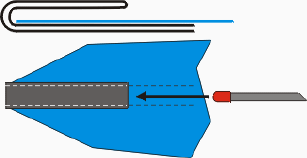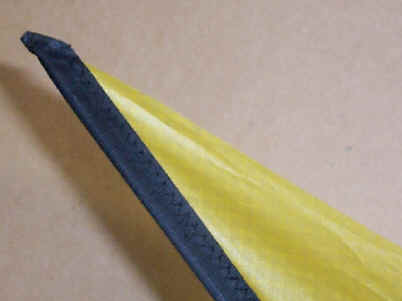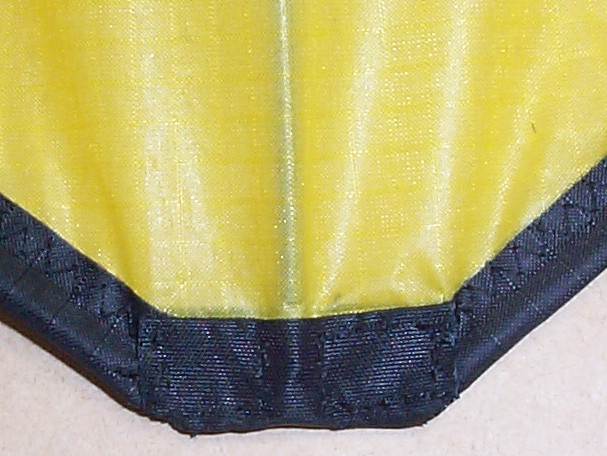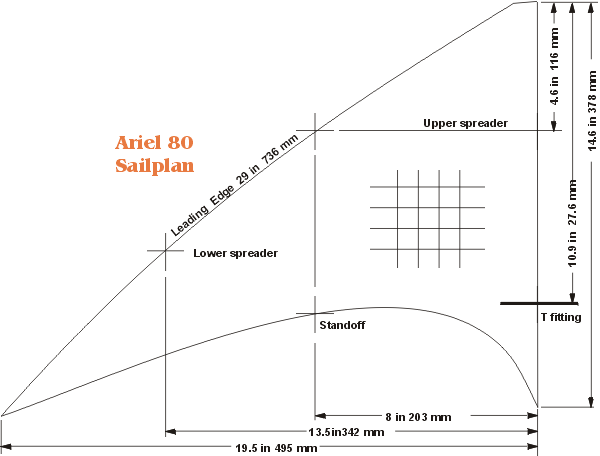|
Ariel Mini
Plan
Ariel scaled to
80%
|
 Almost
any small kite like this is usually confused with the popular Micron. This
is shallower and much lighter, and flies in lower wind. The response of such
a light kite is amazing, as it leaps from the ground controlled by your
thoughts more than your fingertips. Almost
any small kite like this is usually confused with the popular Micron. This
is shallower and much lighter, and flies in lower wind. The response of such
a light kite is amazing, as it leaps from the ground controlled by your
thoughts more than your fingertips.
The first Ariel
was made for very high winds, but this is a version comparable to the
zero-wind Trick-Tac. The one-piece sail is 1/2 ounce nylon with a
hot-cut trailing edge, 3/4 ounce rip-stop leading edge sleeves and
spine pocket. The reinforcement at the center T is rip-stop adhesive
tape and whiskers are 040. It may not need an upper spreader, but the fittings are
there anyway for testing. The 080 carbon spine and 24 inch leading
edge spars are sewn in place to save weight, and to clean up the
edges. The three main rods are inserted into the
nose, and the nose folds over them like an envelope flap. The
sail is reduced to 80% of the Ariel,
and spars are fitted by eye. The bridle is 50 pound Dacron, thick
enough to avoid snags. On other kites, very thin bridles have hung up
on everything, negating any weight advantage.
Wind range starts at
around 1-2 mph and at that speed tricks quite well on 35 foot lines.
Re-launching from odd positions is a snap, except for that one. The upper spreader of
050 rod seems useless except in stiff breezes. A larger Orcon
version with tapered 060 rods and a bridle of sewing thread might be
fun.
|
| This is my
response to the Trick-Tac, and I like it even better. With a .080
frame and a light sail, this kite loves to do tricks in light
wind. The sail is too small to be an indoor kite, but it flies
outdoors when only fighters are up. It is a durable little
thing that only needs an upper spreader in medium winds. Left
off were knocks, elastic, trailing edge hem, leech line, trick line,
extra seams and reinforcements. The sail is cut in one
piece, the LE sleeves attached, and the wingtips are sewn shut.
Spars are inserted into the nose and a flap of 3.8 ounce Dacron sewn
over the spar ends. I did this by hand to feel and apply the right
tension to the spar. The dynamic bridle is a bit thick and
short-legged to reduce snagging, and could be much
lighter. |
 |

A 10mm x 150mm strip of .75 ounce nylon
forms the spine pocket. It is folded in half, then re-folded 25mm
from that fold. This wraps around the tail to form a pocket for
the spine
A 5mm vinyl cap serves as a T fitting.
The hole for it is strengthened with rip-stop tape.
|
 |
The wingtips are as simple as
possible to reduce weight and line snagging protrusions.
A trick line and leech line aren't necessary on
such a tiny kite.
A friend liked this kite enough to swap a Micron
for it, and the comparison is interesting. This kite is very
different from the Micron, especially in the shallow sail and wider
stance of the standoffs. The simple wingtips are similar, which
surprised me.
The Micron has a higher wind range, but could
still be put on a diet, and the bridle invites
experimenting.
|
 |
Spars are inserted into the
nose with a flap of 3.8 ounce Dacron sewn over the spar ends by
hand. A machine foot would have a hard time with this lumpy
juncture, and keeping tension on the spars is easier this
way.
I hope to expand this method to
full-sized kites using internal tensioning.
If you make one of these please let me know of
any mistakes in the plan.
Fair Winds,
Stan
|
|
Frame
Dimensions |
| Leading
edge |
080 Carbon |
24.6 inches |
625 mm |
| Spine |
080 Carbon |
14.6 inches |
370 mm |
| Upper
Spreader |
050 Carbon |
10.2 inches |
260 mm |
| Lower
spreader |
080 Carbon |
23.8 inches |
605 mm |
| Stand-offs |
.040 Carbon |
3.75 inches |
95 mm |
|
Parts and
Materials |
| Leading edge
strip and nose |
.75 ounce
Nylon 20mm wide |
| Sail |
1/2 ounce
Nylon |
| Leech
line |
None |
| Bridle
line |
50 pound
Polyester |
| Nocks |
None |
| Leading edge
connectors |
.080
rubber |
| Standoff to
Spreader |
.080
rubber |
| Standoff to
sail |
Smallest
possible |
| T-connector |
A 6mm Vinyl
end cap, pierced for
spars |


|
Bridle
Dimensions |
 |
|
A prusik knot attaches
the tow loop (red) to the inhaul line (green), and another one
ties the inhaul (green) to the purple outhaul
(purple). | |